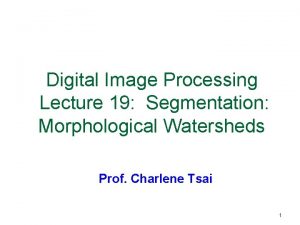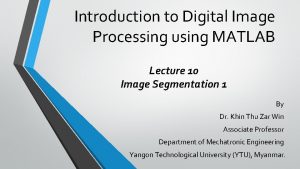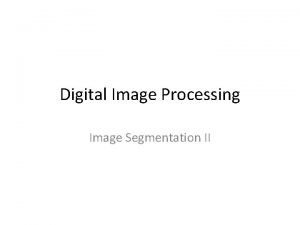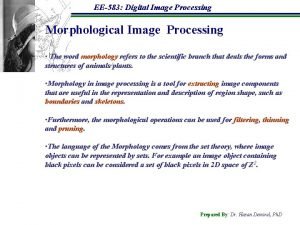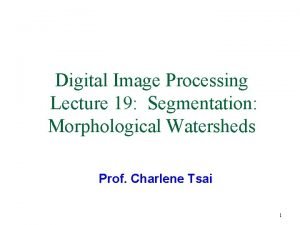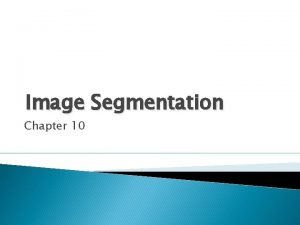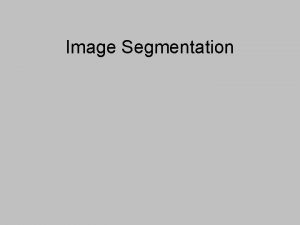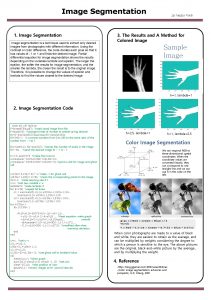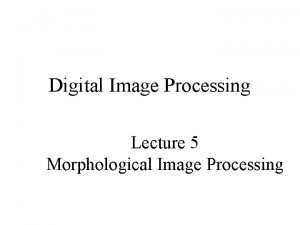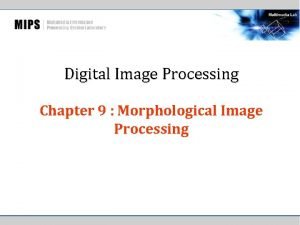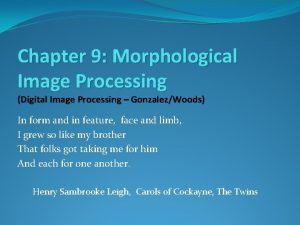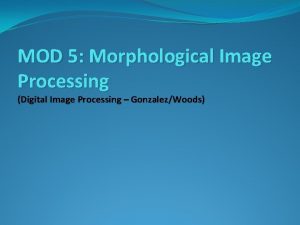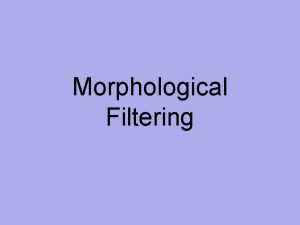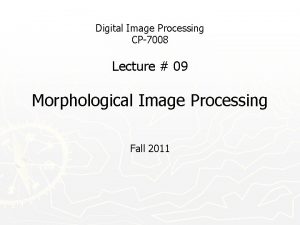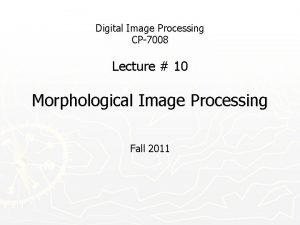Digital Image Processing Lecture 19 Segmentation Morphological Watersheds








![Flooding n n Initialization: C[min+1]=T[min+1] Obtain C[n] from C[n-1] (recursively): q q Let Q Flooding n n Initialization: C[min+1]=T[min+1] Obtain C[n] from C[n-1] (recursively): q q Let Q](https://slidetodoc.com/presentation_image/bf70edf1da14a524c54262f0853e074a/image-9.jpg)
![Constructing C[n] n Scenario (a) [empty]: a new minimum is found q n Scenario Constructing C[n] n Scenario (a) [empty]: a new minimum is found q n Scenario](https://slidetodoc.com/presentation_image/bf70edf1da14a524c54262f0853e074a/image-10.jpg)
![Dam Construction of height max+1 In C[n-1] q Scenario (c) 11 Dam Construction of height max+1 In C[n-1] q Scenario (c) 11](https://slidetodoc.com/presentation_image/bf70edf1da14a524c54262f0853e074a/image-11.jpg)



![Step 1 (n=1): n n n T[1]=? C[1]=? Q[1]=? 15 Step 1 (n=1): n n n T[1]=? C[1]=? Q[1]=? 15](https://slidetodoc.com/presentation_image/bf70edf1da14a524c54262f0853e074a/image-15.jpg)
![Step 2 (n=2): n n n T[2]=? Q[2]=? C[2]=? 16 Step 2 (n=2): n n n T[2]=? Q[2]=? C[2]=? 16](https://slidetodoc.com/presentation_image/bf70edf1da14a524c54262f0853e074a/image-16.jpg)
![Step 3 (n=3, 4): n n T[3]=? Q[3]=? C[4]=? 17 Step 3 (n=3, 4): n n T[3]=? Q[3]=? C[4]=? 17](https://slidetodoc.com/presentation_image/bf70edf1da14a524c54262f0853e074a/image-17.jpg)
![Step 5 (n=5): n n n T[5]=? Q[5]=? C[5]=? 18 Step 5 (n=5): n n n T[5]=? Q[5]=? C[5]=? 18](https://slidetodoc.com/presentation_image/bf70edf1da14a524c54262f0853e074a/image-18.jpg)

- Slides: 19

Digital Image Processing Lecture 19: Segmentation: Morphological Watersheds Prof. Charlene Tsai 1

Introduction n Review: We have done q q q n Detection of discontinuities Thresholding Region processing Morphological watersheds embodies properties from other 3 approaches, therefore more superior. 2

Basic Concept n Visualize the image in 3 D topography (地勢) q n 3 types of points: q q q n 2 spatial coordinates + graylevel (a) Points in a regional minimum (b) Points on hills (c) Points on watershed lines Water level c b c a How to differentiate (b) & (c)? 3

Illustration n Objective: finding the watershed lines q Construction of dam to prevent catchment basins from merging Catchment basins Watershed lines Original image Topographic view 4

(con’d) n Punch a hole in each regional minimal for water to fill up the catchment basin. 5

(con’d) Water start merging, so shorter dam constructed Longer dam constructed Final result 6

Aside n Watershed algorithm is often applied to the gradient of an image, rather than to the image itself. q q Regional minima of catchment basins correlate nicely with the small value of the gradient corresponding the objects of interest Boundaries are highlighted as the watershed lines. 7

Watershed Segmentation Algorithm n Starting with the notation: q q g(x, y) is the image with min and max the lowest and highest graylevel, respectively M 1, M 2, … MR be the regional minima T[n]={ (s, t) | g(s, t)<n } Cn(Mi) is the set of (s, t) in the catchment basin of Mi that are flooded at stage n. q n C[n-1] is a subset of C[n] and C[n] is subset of T[n]. So it implies that q Each connected component (CC) of C[n-1] is contained in exactly one CC of T[n]. 8
![Flooding n n Initialization Cmin1Tmin1 Obtain Cn from Cn1 recursively q q Let Q Flooding n n Initialization: C[min+1]=T[min+1] Obtain C[n] from C[n-1] (recursively): q q Let Q](https://slidetodoc.com/presentation_image/bf70edf1da14a524c54262f0853e074a/image-9.jpg)
Flooding n n Initialization: C[min+1]=T[min+1] Obtain C[n] from C[n-1] (recursively): q q Let Q be the set of CC in T[n], and 3 possibilities for : (a) empty (b) containing one CC of C[n-1] (c) containing more than one CC of C[n-1] 9
![Constructing Cn n Scenario a empty a new minimum is found q n Scenario Constructing C[n] n Scenario (a) [empty]: a new minimum is found q n Scenario](https://slidetodoc.com/presentation_image/bf70edf1da14a524c54262f0853e074a/image-10.jpg)
Constructing C[n] n Scenario (a) [empty]: a new minimum is found q n Scenario (b) [containing 1 CC]: q lies in the catchment basin of some regional minimum q n q is incorporated into C[n-1] to form C[n] Scenario (c) [containing 1+ CC], part of the watershed line is encountered. q A dam must be build within q to prevent overflow between the catchment basins. 10
![Dam Construction of height max1 In Cn1 q Scenario c 11 Dam Construction of height max+1 In C[n-1] q Scenario (c) 11](https://slidetodoc.com/presentation_image/bf70edf1da14a524c54262f0853e074a/image-11.jpg)
Dam Construction of height max+1 In C[n-1] q Scenario (c) 11

(con’d) n Dilate each CC of by the structuring element B, subject to 2 conditions: q q Dilation constrained to q (origin of B located in q) Dilation cannot cause merging of CC’s being dilated Change the height to max+1 B 12

Example Gradient image Segmente d image 13

Exercise n Give a step-by-step implementation of the dam building procedure for the onedimensional gray-level cross section shown. Show a drawing of the cross section at each step, showing “water” levels and dams constructed. g(x) 14 x
![Step 1 n1 n n n T1 C1 Q1 15 Step 1 (n=1): n n n T[1]=? C[1]=? Q[1]=? 15](https://slidetodoc.com/presentation_image/bf70edf1da14a524c54262f0853e074a/image-15.jpg)
Step 1 (n=1): n n n T[1]=? C[1]=? Q[1]=? 15
![Step 2 n2 n n n T2 Q2 C2 16 Step 2 (n=2): n n n T[2]=? Q[2]=? C[2]=? 16](https://slidetodoc.com/presentation_image/bf70edf1da14a524c54262f0853e074a/image-16.jpg)
Step 2 (n=2): n n n T[2]=? Q[2]=? C[2]=? 16
![Step 3 n3 4 n n T3 Q3 C4 17 Step 3 (n=3, 4): n n T[3]=? Q[3]=? C[4]=? 17](https://slidetodoc.com/presentation_image/bf70edf1da14a524c54262f0853e074a/image-17.jpg)
Step 3 (n=3, 4): n n T[3]=? Q[3]=? C[4]=? 17
![Step 5 n5 n n n T5 Q5 C5 18 Step 5 (n=5): n n n T[5]=? Q[5]=? C[5]=? 18](https://slidetodoc.com/presentation_image/bf70edf1da14a524c54262f0853e074a/image-18.jpg)
Step 5 (n=5): n n n T[5]=? Q[5]=? C[5]=? 18

Dam Construction: 19
 Segmentation by morphological watersheds
Segmentation by morphological watersheds Morphological
Morphological Key stages in digital image processing
Key stages in digital image processing Double thresholding matlab
Double thresholding matlab Segmentation in digital image processing
Segmentation in digital image processing Segmentation in digital image processing
Segmentation in digital image processing Histogram processing in digital image processing
Histogram processing in digital image processing Neighborhood processing in image processing
Neighborhood processing in image processing Neighborhood processing in digital image processing
Neighborhood processing in digital image processing Point processing in image processing
Point processing in image processing Fractal
Fractal Morphological operations in image processing
Morphological operations in image processing Translate
Translate Noise
Noise Compression models in digital image processing
Compression models in digital image processing Variable length coding in digital image processing
Variable length coding in digital image processing Image sharpening in digital image processing
Image sharpening in digital image processing Geometric transformation in digital image processing
Geometric transformation in digital image processing Zooming and shrinking of digital images
Zooming and shrinking of digital images Image transform in digital image processing
Image transform in digital image processing
